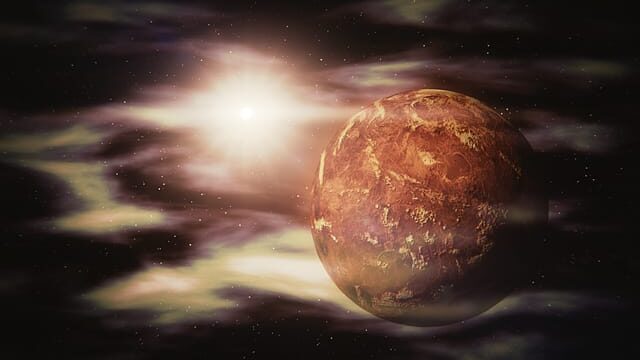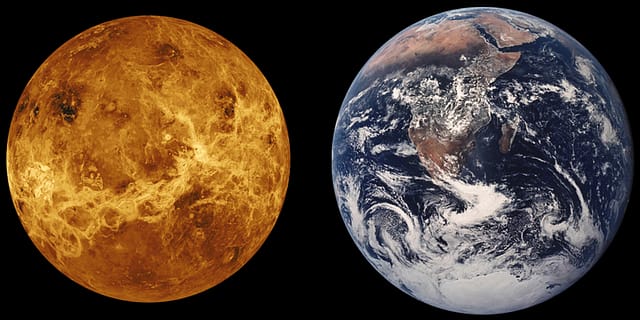The second planet from the Sun, Venus is one of the hottest planets in the solar system. It is the only planet named after a female, after the Roman goddess of love and beauty. Known as the day and night star, Venus is the twin of Earth for various reasons.
In this article, we are going to know more about the planet Venus, its characteristics, and if we have explored venus. We will also get to know which countries have explored Venus. We have explored Mars, and continue to do so, will that motivate us to explore Venus too?
What are the characteristics of Venus?
Venus and Earth are often called twin planets because they are quite similar to each other in terms of mass, size, composition, gravity and density. It is around 80% of Earth’s mass and is just a little small in size than the Earth. The core of Venus is nearly 6000 km wide and is made up of metallic iron, whereas the mantle is around 3000 km thick while the crust consisting mostly of basalt is 15 to 20 km thick.
Related: Venus has a higher average Surface temperature than Mercury Why?
Why is Venus so hot?
Despite being the second planet to Sun, it is the hottest planet in the solar system. Do you know the reason behind this? Although it is second from Sun, the thick atmosphere of Venus doesn’t allow the heat to release and traps it inside it.
This creates the common greenhouse effect which handles increasing temperatures on Earth. The temperatures can reach roughly 470 degree Celsius, high enough temperature to melt lead.
The lucky space crafts that have landed on Venus have not been able to survive for more than a few hours due to these scorching temperatures.
The Venusian atmosphere and surface
Venus’ atmosphere consists of carbon dioxide, clouds of sulphuric acid and small amounts of water. Venus has the densest atmosphere of any planet in our solar system.
It makes the surface pressure around 90 times more than that of Earth. Due to this extreme heat, the surface is also very dry. The surface has no liquid water as the heat made the water boil away.
The surface of Venus consists of smooth flat plains marred by many volcanoes. some of which are still alive which can create lava canals that are more than 5000 km in length.
No other planet has such long volcanic lava canals. It also has a different type of surface feature called coronae or crowns which are around 1200 km wide. Scientists believe that they formed when hot material from the inner of Venus rose, which warped the surface.
Other characteristics
Venus is much brighter than any other planet or star and can is visible in a clear night sky. This brightness is due to the high reflective clouds of Venus and its less distance from us.
The planet Venus takes 243 Earth days to complete one rotation around its axis. This speed of rotation is the slowest among any major planets. This slow spin doesn’t allow the planet to have a high magnetic field.
Apart from its slow spin, it takes 225 Earth days to revolve around the Sun. This is the Venusian year. This means that days on Venus are longer than years. But due to the indifferent rotation, the time between two sunrises is around 117 Earth days.
Another special feature of Venus is that it is the only planet to rotate from west to east, contrary to all the other planets. Thus, the sun appears to rise from the west and set in the east on Venus which is opposite to that of Earth.
What is the Venus’ climate
The topmost layer of clouds on Venus moves around the planet motioned by fast winds of nearly 360 kmph. This is a major mystery for researchers that how the planet’s atmosphere moves around 60 times faster than the planet itself. Some unusual stripes of clouds are seen in the upper layers of clouds.
They absorb the light in blue and ultraviolet ranges and show the colour. They absorb a huge amount of energy, an amount that is nearly half the value of solar energy the entire planet absorbs.
A mission by the European Space Agency found traces of lightning. They were inside the sulphuric acid clouds unlike the ones formed in water clouds on Earth.
This lightning is of great interest for researchers. They think that electrical discharges could form molecules that could be the beginning of life on Venus.
Which countries have explored Venus?
Only a few handfuls of countries or organizations have explored Venus. This includes the Soviet Union, NASA, European Space Agency and the Japan Aerospace Exploration Agency. They have deployed many spacecraft for Venus till now. Some of the prominent missions to Venus are below:
- Mariner 2 It was the first successful mission to any planet. It flew past Venus on December 14, 1962. It recorded the temperatures of the planet and found them to be around 480 degree Celsius. It also detected the composition, density and solar wind variations.
- Venera 4 It was a mission by the Soviet Union which was the first to transmit information of Venus’ atmosphere. It made into the atmosphere on October 18th 1967 and found that the atmosphere consisted of 90-95% of carbon dioxide.
- Mariner 5 The spacecraft which went closes to Venus, the Mariner 5 by NASA measured the magnetic fields and detected the emissions and waves refracted by the planet.
- Venera 7 Launched by the Soviet Union in 1970, it was the first spacecraft to land on the surface and successfully return information after landing. It had a hard and tough landing on December 15, 1970, on the surface. It sent weak signals back to Earth for around 23 minutes and gathered information regarding the atmosphere and surface.
- Venera 8 Another mission by the Soviet Union which landed on the Venusian surface in 1972, the Venera 8 send information for 63 minutes. After this, it was destroyed by high pressure and temperature. This clearly depicted that the planet had high surface pressure.
- Mariner 10 This was a special mission by NASA which used the gravity of one planet to reach another planet that was Mercury. This made the spacecraft the only one to visit two planets.
- Pioneer Venus orbiter It successfully entered orbit on December 4th 1978 and sent back important information about the atmosphere and surface. A probe from the mission also landed on the surface and sent information for more than an hour.
- Magellan This mission by NASA in 1990 lasted for more than four years after which radio contact to it was lost. It mapped the surface and understood the topography of the surface. This was a very crucial mission for all the information it provided.
- Cassini-huygens mission This was a joint mission by NASA and the European Space Agency which used Venus to pick up speed and reach Saturn. The flybys occurred on April 26, 1998, and June 24, 1999. It safely reached Saturn in 2004 and examined the planet and moons for years. A probe called Huygens also landed on the surface of one of its moon Titan.
- Venus Express The first successful mission by a country besides the US and the Soviet Union, the Venus Express was launched by the European Space Agency in 2005. Its mission was to study the planet’s atmosphere and plasma. It plunged into the atmosphere in 2014 and sent some crucial information about the greenhouse effect, solar wind and the magnetic field.
- Akatsuki The new country arises as Japan launches its first orbiter at Venus. It attempted to enter orbit on December 6th 2010 but faced a problem but was in good health for five years and Japan launched another spacecraft in 2015 which successfully entered the orbit. Since then, it has been sending information about the atmosphere and the clouds.
- Recently on June 2nd 2021, NASA announced its two new missions named DAVINCI+ and VERITAS. These missions are expected to launch between 2028 and 2030.
Only a handful of countries have explored Venus. With the advancements in technology and resources, over time more countries will begin their missions for landing on Venus and gathering information about it. Till then, this was our answer to which countries have explored Venus!
Conclusion
Venus is the second planet from Sun and has been the centre of exploration for decades. NASA began the quest of exploring Venus. The Soviet Union and the European Space Agency followed soon. The latest entry to this unique list is Japan.
Although, a few countries but they have done a lot in the field of exploration of Venus. Various further missions are being planned throughout the world. They will help us gain a detailed explanation of every question about Venus.
——————————————
Recent posts:

